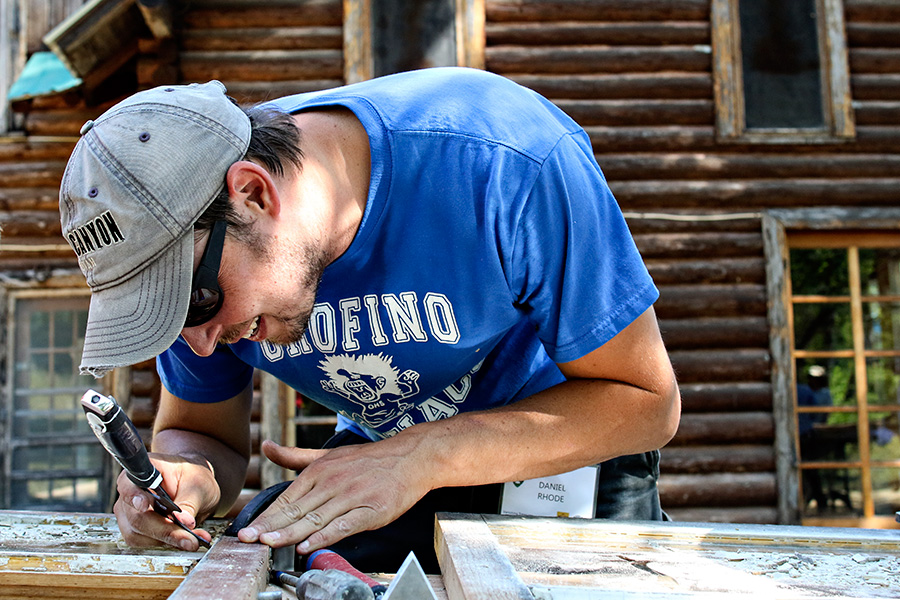Preserving History on the Shores of Lake McDonald
National Park Service teams up with preservationists to stabilize historic Wheeler Cabin
By Justin Franz
LAKE McDONALD — Amid record visitation to Glacier National Park, it can be challenging to find a quiet and peaceful spot near Going-to-the-Sun Road. But if you take the right turn and know where to go, it’s still possible to find tranquility.
One of those places is the Wheeler Cabin, on the north shore of Lake McDonald, less than a mile from the busy Sun Road. On a recent calm Thursday morning, the only noise was an occasional pounding of a hammer.
For two weeks in mid-July, the National Park Service teamed up with preservation groups to work on the historic Wheeler Cabin, once the summer home of U.S. Sen. Burton Wheeler, who served in Washington, D.C., as a Democrat for 24 years and was nominated to be the vice presidential candidate for the Independent Progressive Party in the 1920s.
The Wheeler Cabin is on the National Register of Historic Places and was acquired by the Park Service in 2014. Glacier National Park officials are currently evaluating a number of possible uses for the cabin, which was built in 1941, but right now the primary goal is to stabilize the structure. In an effort to get the most out of those stabilization efforts, the Park Service invited preservationists from around the country to work on the building and learn skills that can be applied to other structures.
Cultural Resource Program Manager Sierra Mandelko said the methods of working on an historic building are much different than for a new building. In order to preserve the cabin’s structural integrity, workers use materials and methods that were common when the building was constructed.
“These types of buildings can be found all over the West, so the skills that people learn here can be applied elsewhere,” Mandelko said.
Representatives from the Montana Preservation Alliance, Xanterra, Portland State University and other units within the National Park Service participated in the project. The Glacier National Park Conservancy offered a $35,000 grant to cover the cost of the work session. Among the tasks performed over the two weeks was restoration of the doors and windows. After years out in the elements, many of the doors had lost their shine, so each one was taken off, sanded down and then coated with linseed oil to protect it. Masons also worked on the chimney.
Glacier Spokesperson Lauren Alley noted that park maintenance employees take care of the building year-round; on occasion, Superintendent Jeff Mow mows the lawn.
Dustin Kalanick, restoration director for the Montana Preservation Alliance, said that using older techniques to restore a building helps teach important skills to a new generation. He also said that preservation groups achieve more when collaborating like they have with the Wheeler property.
“This collaborative effort is reflective of what Sen. Wheeler believed, that if you work together, you can get things done,” he said.
The Wheeler family first came to Glacier Park in the 1910s, when Burton was U.S. District Attorney for Montana. He was elected to the U.S. Senate in 1922. The Wheelers purchased a cabin not far from Lake McDonald Lodge and lived there during the summer until it burned in 1941. Wheeler’s wife Lulu designed the current structure, which was built soon after. The two-story home has a large kitchen, living room and four bedrooms.
Wheeler and his colleague, Sen. Thomas Walsh, helped push the appropriations bill that paid for the construction of the Sun Road.
Wheeler hosted a number of dignitaries, including President Franklin D. Roosevelt, who came in 1935 to dedicate the Sun Road. Wheeler and Roosevelt had an at-times tumultuous relationship, despite representing the same party. Wheeler supported many of the president’s New Deal initiatives but also fought against Roosevelt’s plan to add six more justices to the Supreme Court. In 1940, Roosevelt asked Wheeler to be his running mate, but the Montana senator turned him down because he disagreed with the president’s interventionist policies overseas.
According to legend, Wheeler took numerous important phone calls from his cabin, and, due to the primitive nature of phone service at Lake McDonald in the 1930s and 1940s, nearby fire lookouts were occasionally able to discreetly listen in.
Wheeler died in 1975, but the cabin remained in the family until the 2000s, when it and a number of other buildings on the property were handed over to the Park Service. Although the family is gone, the story of Wheeler and his connection to Glacier lives on.
“If you don’t believe a building has a soul, then spend a few minutes at the (Wheeler Cabin),” Kalanick said. “It’s a special place.”